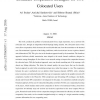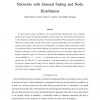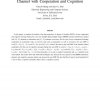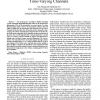CORR
2007
Springer
13 years 4 months ago
2007
Springer
— We study the high-power asymptotic behavior of the sum-rate capacity of multi-user interference networks with an equal number of transmitters and receivers. We assume that each...
CORR
2007
Springer
13 years 4 months ago
2007
Springer
A K-user memoryless interference channel is considered where each receiver sequentially decodes the data of a subset of transmitters before it decodes the data of the designated t...
CORR
2006
Springer
13 years 4 months ago
2006
Springer
This work considers the problem of communication from a single transmitter, over a network with colocated users, through an independent block Rayleigh fading channel. The colocati...
CORR
2006
Springer
13 years 4 months ago
2006
Springer
A fading broadcast channel is considered where the transmitter employs two antennas and each of the two receivers employs a single receive antenna. It is demonstrated that even if...
CORR
2008
Springer
13 years 4 months ago
2008
Springer
The capacity of a time-varying block-memoryless channel in which the transmitter and the receiver have access to (possibly different) noisy causal channel side information (CSI) i...
CORR
2010
Springer
13 years 4 months ago
2010
Springer
In many wireless systems, interference is the main performance-limiting factor, and is primarily dictated by the locations of concurrent transmitters. In many earlier works, the l...
CORR
2008
Springer
13 years 4 months ago
2008
Springer
In this paper, we explore the benefits, from the perspective of degrees of freedom (DOF), of user cooperation and cognitive message sharing for a two-user multiple-input-multiple-...
MOBICOM
2010
ACM
13 years 4 months ago
2010
ACM
A wireless transmitter learns of a packet loss, infers collision, only after completing the entire transmission. If the transmitter could detect the collision early (such as with ...
MSWIM
2006
ACM
13 years 10 months ago
2006
ACM
We present an efficient algorithm to compute the coverage map of a given set of transmitters under interference constraints. That is, we compute the set of points that lie within ...
ICC
2007
IEEE
13 years 11 months ago
2007
IEEE
—— The performance of multiuser MIMO downlink systems with block diagonalization (BD) relies on the channel state information (CSI) at the transmitter to a great extent. For ti...




